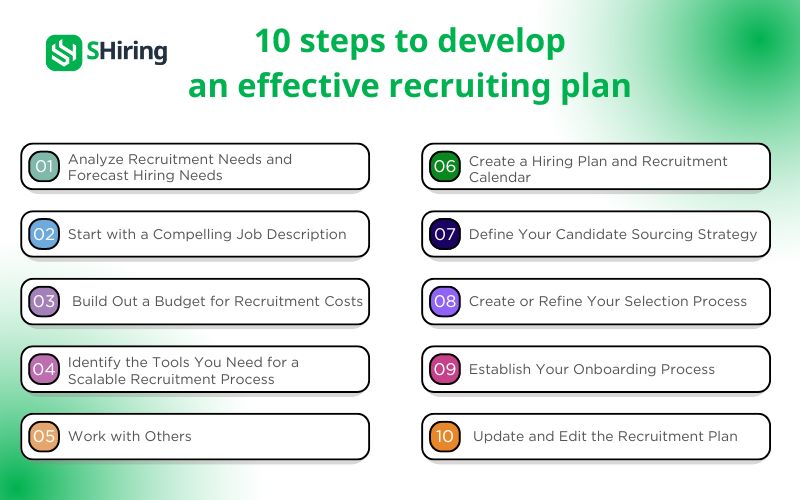Recruiting top talent is crucial for any organization to thrive and meet its business objectives. A well-structured recruitment plan serves as a roadmap, guiding the entire hiring process from identifying needs to onboarding new employees. By following a strategic approach, companies can attract the right candidates, streamline their efforts, and build a talented workforce that drives success.
What is a recruitment plan?
A recruitment plan is a document that outlines the strategies and steps a company will take when hiring for a job position. Recruiting plans enable business owners and managers to focus their efforts and resources on effective hiring strategies. They can be adjusted for each new position while still providing consistent methods for attracting and selecting candidates. Recruiting plans should be updated over time to improve the process based on hiring experience.
A basic recruiting strategy should include the following details:
- Job description: Including list of requirements and responsibilities, salary and benefits that can be offered.
- Details about the position: Number of hires needed, whether full-time/part-time/contract roles.
- Timeline: Deadlines for each step in the hiring process.
- Target audience: Description of ideal candidate traits and target applicant pool.
- Outreach methods: List of marketing strategies to reach candidates like job boards, social media, events.
- Evaluation plan: Methods for evaluating candidates through interviews, application materials.
Recruiting plans provide benefits like creating consistency in the process, guiding hiring staff, being easy to update, and helping attract candidates by demonstrating professionalism.

10 steps to create an effective recruitment plan for your business
Recruiting top talent is crucial for any organization to thrive and meet its business objectives. A well-structured recruitment plan serves as a roadmap, guiding the entire hiring process from identifying needs to onboarding new employees. By following a strategic approach, companies can attract the right candidates, streamline their efforts, and build a talented workforce that drives success. Here are 10 simple steps to create an effective recruiting plan for your business:

Step 1: Analyze recruitment needs and forecast hiring needs
Begin by evaluating your current workforce capabilities and anticipating future requirements. Identify which roles need to be filled immediately and which may be needed down the line. This step involves analyzing skill gaps within the organization to determine the type of candidates required. Understanding these needs will help in targeting the right talent at the right time.
Step 2: Start with a compelling job description
Clear and detailed job descriptions are essential. These should outline the responsibilities, requirements, and expectations for each position. Highlight the benefits and unique aspects of your company to attract top talent. Additionally, use inclusive language to encourage a diverse range of applicants, ensuring that you don’t unintentionally discourage any potential candidates from applying.
Step 3: Build out a budget for recruitment costs
Estimate the costs associated with job advertising, recruiting software, background checks, and recruitment agencies if needed. Don’t forget to consider additional expenses such as relocation costs, signing bonuses, and training for new hires. Having a well-defined budget helps in managing resources efficiently and avoiding unexpected expenses.
Step 4: Identify the tools you need for a scalable recruitment process
Investing in the right tools can streamline the recruitment process. Applicant tracking systems (ATS) are essential for managing applications and tracking candidates. Utilize recruitment marketing tools and platforms to reach a broader audience. Consider tools for resume screening, interview scheduling, and candidate communication to enhance efficiency and scalability.
Step 5: Work with others
Recruitment is a team effort. Engage hiring managers and team members in the recruitment process. Develop a clear communication plan to keep everyone informed about their roles and responsibilities. Encourage feedback and suggestions to continuously improve the recruitment process, fostering a collaborative environment that enhances the overall strategy.
>> 7 Aspects of ATS implementation: Improve candidate experience

Step 6: Create a hiring plan and recruitment calendar
Establish realistic deadlines for each stage of the recruitment process. Plan for peak hiring periods and ensure resources are available to manage increased workloads. Schedule regular check-ins to track progress and make necessary adjustments. A well-structured plan and calendar help in maintaining a smooth and organized recruitment process.
Step 7: Define your candidate sourcing strategy
Determine the best channels to source candidates, such as job boards, social media, and recruitment agencies. Build a talent pipeline by maintaining relationships with potential candidates and industry contacts. Use employee referrals to tap into a network of qualified candidates, leveraging existing employees’ networks to find the best talent.
Step 8: Create or refine your selection process
Create a structured interview process that includes standardized questions and evaluation criteria. Use assessments and tests to measure candidates’ skills and cultural fit. Ensure a fair and unbiased selection process by training interviewers and using diverse interview panels. A refined selection process helps in making informed and objective hiring decisions.
Step 9: Establish your onboarding process
Design an onboarding program that helps new hires integrate into the company culture and become productive quickly. Include orientation sessions, training programs, and regular check-ins with managers. Providing necessary resources and support ensures a smooth transition for new employees, setting them up for success from day one.

Step 10: Update and edit the recruitment plan
Regularly review the recruitment plan to identify areas for improvement. Gather feedback from new hires, hiring managers, and recruiters to understand what works well and what needs adjustment. Stay updated with industry trends and best practices to continuously refine the recruitment strategy. An adaptable plan allows for ongoing improvement and sustained success in recruitment efforts.
By following these steps, organizations can create a comprehensive and effective recruitment plan that meets their current and future hiring needs, attracts top talent, and fosters a diverse and productive workforce.
Recruitment plan template
Jim Collins once said, ‘Great vision without great people is irrelevant.’ This quote underscores the importance of having a solid recruitment plan in place to attract and retain the right talent to execute the company’s vision effectively.

Guided by this principle, the subsequent template delineates an approach to crafting a tailored recruitment plan aligned with the unique requirements of your organization:
Recruitment Plan Template
Business Name/Department: [Insert]
Date: [Insert]
Prepared by: [Insert Name], [Insert Job Title]
Recruitment Goals
- [List SMART recruitment goals]
Positions to Fill
- [List positions to be filled with reasons, weekly working hours, and approximate salary]
Target Candidates
- [Describe desired qualities in candidates]
Talent Sourcing Methods
- [List methods for attracting potential candidates]
Applicant Evaluation Methods
- [List methods for assessing candidates]
Projected Yearly Recruitment Budget
- Total Budget: $[Insert]
- Number of New Recruits: [Insert]
- Estimated Cost per Additional Hire: $[Insert]
- Breakdown of Expenses:
- [Detailed List of Recruitment Expenses]
Apply SHiring in building a recruitment plan
Effective planning and technology integration enhance your recruitment strategies. With its superior features, SHiring helps businesses optimize efficiency, costs, and resources for their recruitment activities. As a result, recruitment plans are ensured to be implemented effectively and efficiently.
In particular, with its outstanding features, SHiring creates a pleasant experience for candidates approaching the business, contributing to enhancing a sustainable recruitment brand.

The superior features SHiring supports in recruitment include:
- Cv parsing technology
- Centralized cv management
- Talent pool-based access control
- Job posting creation and display on careersite
- Recruitment campaign and position management
- Recruitment process management
- In-depth recruitment result reporting and analysis
- Propose suitable candidates for the recruitment position through AI technology.
- Integration with external services
Explore how Shiring simplifies team-based hiring, streamlines processes, and facilitates the evaluation of recruitment outcomes.
Read more: SHiring – Efficient recruitment solution integrating AI and ATS
Conclusion
By following these 10 simple steps, organizations can create a comprehensive and effective recruitment plan that meets their current and future hiring needs. A well-thought-out recruitment plan not only attracts top talent but also fosters a diverse and productive workforce, ensuring your business continues to thrive and achieve its goals. Regularly updating and refining your plan will help you stay ahead of industry trends and maintain a competitive edge in the talent market.


